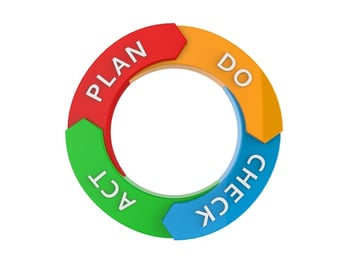 Successful organizations are often determined by their process and their willingness to evolve. The more granular, and focused the organization is on planning, implementing, reviewing and refining its processes, the better. This method is often referred to as the plan-do-check-act cycle, aka PDCA, a four-step process used for continuous improvement. PDCA is an on-going and joint team effort that organizations use to ultimately improve products, services and internal processes for breakthrough performance.
Successful organizations are often determined by their process and their willingness to evolve. The more granular, and focused the organization is on planning, implementing, reviewing and refining its processes, the better. This method is often referred to as the plan-do-check-act cycle, aka PDCA, a four-step process used for continuous improvement. PDCA is an on-going and joint team effort that organizations use to ultimately improve products, services and internal processes for breakthrough performance.
Building a PDCA continuous improvement process
Phase 1: Plan
Every successful product, service or process starts with a plan. In an effort to grow your business, you must first identify a problem you're experiencing, assess why it's happening in the first place and set SMART goals for your business, as well as each member of your team to make a positive change.
To accomplish this, first measure the bandwidth of your team to determine how much time and resources are necessary in order to deliver on your desired outcome. Take employee training for example—if you're looking to improve your training program to ultimately grow your team and your business, establish your goals first and hen outline the steps necessary in order to see improvement and greater return on your investment.
Phase 2: Do
Once you have a plan in place, it's time to implement your plan. Don't forget to first gain stakeholder approval and support for the process, product or service you're looking to improve. In order to see maximum ROI, your business may benefit from putting strategy, tactic and action behind your implementation—especially if you have the resources to do so. While this is not always necessary, especially for organizations that are new to the PDCA cycle, it can help management determine the role of the team members assigned to the process improvement, as well as the steps they must take for a seamless implementation. As you put your plan into action, be sure to collect key data along the way; these metrics will be used later to measure results.
Phase 3: Check
Now that you have successfully—or even unsuccessfully—implemented your new training program, it's time to analyze the data and validate it against your initial plan. This phase will help you to determine whether or not your training program is effective or ineffective. Ultimately, were you able to meet the goals and objectives that you detailed in the planning phase of the PDCA cycle?
Phase 4: Act
In this phase you will determine whether or not your new process was successful enough to implement on a much larger scale. Say, for example, that you have rolled out an employee training process for new and existing hires. If your employees are growing and improving, you rollout the employee training and development program to other employees who would benefit from business-skills training. If the new training program wasn't a success, start from the beginning of the cycle to see where you may have missed the mark.







